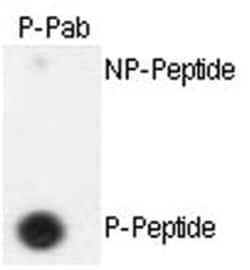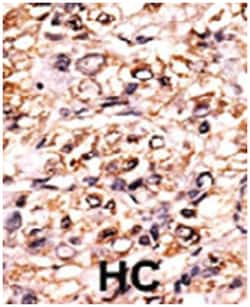Learn More
ESPL1 (phospho S1126), Rabbit anti-Human, Polyclonal Antibody, Abnova™
Rabbit polyclonal antibody raised against synthetic phosphopeptide of ESPL1.
Supplier: Abnova Corporation PAB0608
Description
Stable cohesion between sister chromatids before anaphase and their timely separation during anaphase are critical for chromosome inheritance. In vertebrates, sister chromatid cohesion is released in 2 steps via distinct mechanisms. The first step involves phosphorylation of STAG1 (MIM 604358) or STAG2 (MIM 604359) in the cohesin complex. The second step involves cleavage of the cohesin subunit SCC1 (RAD21; MIM 606462) by ESPL1, or separase, which initiates the final separation of sister chromatids (Sun et al., 2009 [PubMed 19345191]).[supplied by OMIM
Specifications
| ESPL1 | |
| Polyclonal | |
| Rabbit polyclonal antibody raised against synthetic phosphopeptide of ESPL1. | |
| In PBS (0.09% sodium azide) | |
| NP_036423;Q14674 | |
| ESPL1 | |
| Synthetic phosphopeptide (conjugated with KLH) corresponding to residues surrounding S1126 of human ESPL1. | |
| 400 μL | |
| Primary | |
| Human | |
| Liquid |
| Dot Blot, ELISA, Immunohistochemistry (Paraffin) | |
| Unconjugated | |
| Dot Blot (1:500) Immunohistochemistry (1:50-100) The optimal working dilution should be determined by the end user. | |
| ESPL1 | |
| ESP1/FLJ46492/KIAA0165/SEPARASE/SEPARIN | |
| Rabbit | |
| Protein G purification | |
| RUO | |
| 9700 | |
| Store at 4°C. For long term storage store at -20°C. Aliquot to avoid repeated freezing and thawing. |
Your input is important to us. Please complete this form to provide feedback related to the content on this product.
For Research Use Only

